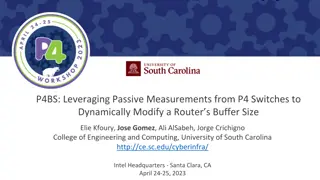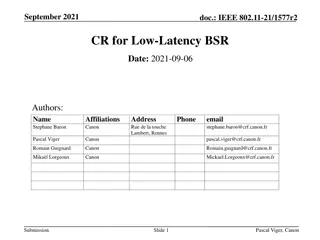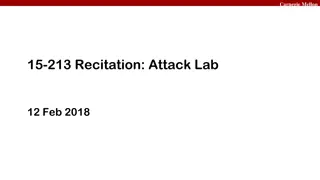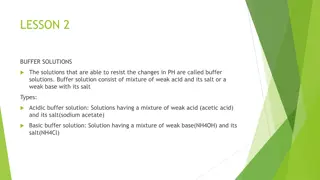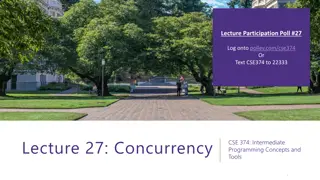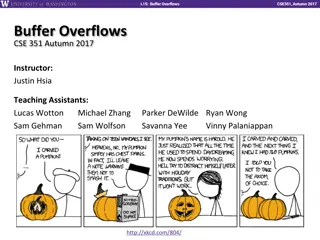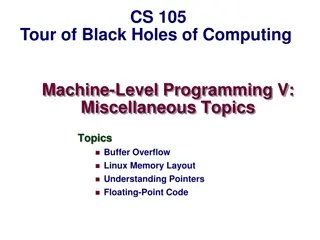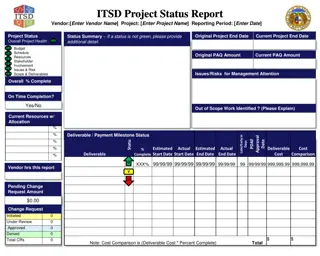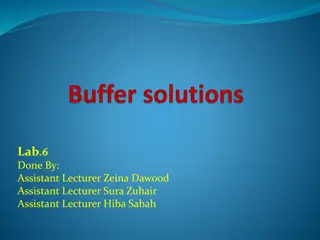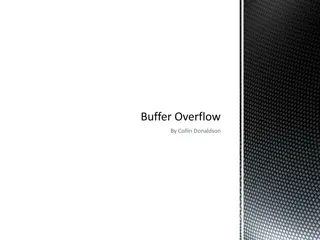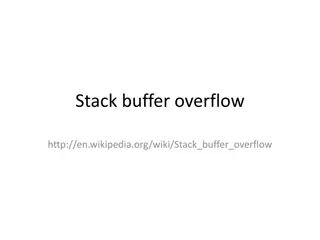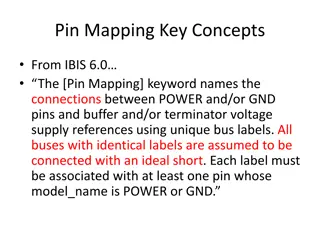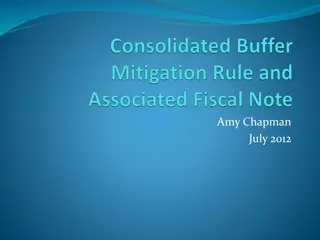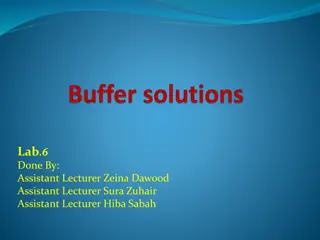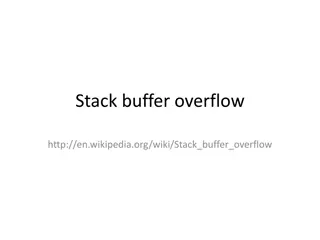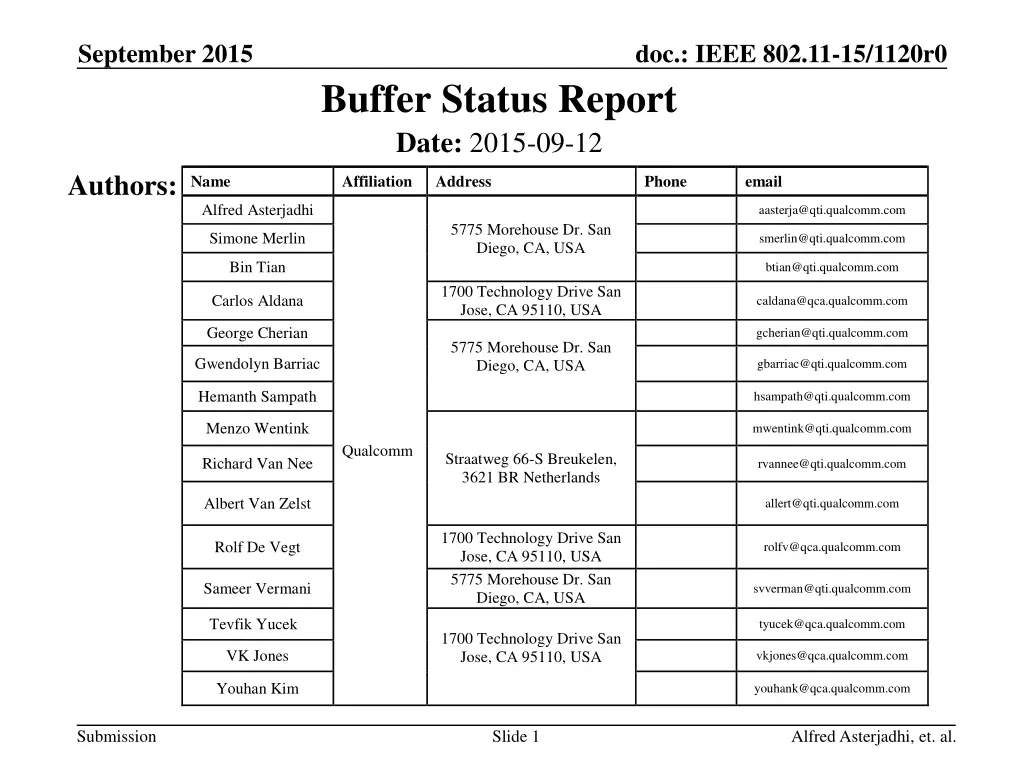
IEEE 802.11-15 Buffer Status Report September 2015
This document provides the Buffer Status Report for IEEE 802.11-15 dated September 12, 2015. It includes authors from various affiliations such as Qualcomm, LG Electronics, Intel, Broadcom, Marvell, and Mediatek. The report covers insights and findings related to buffer status in the specified time frame.
Download Presentation

Please find below an Image/Link to download the presentation.
The content on the website is provided AS IS for your information and personal use only. It may not be sold, licensed, or shared on other websites without obtaining consent from the author. If you encounter any issues during the download, it is possible that the publisher has removed the file from their server.
You are allowed to download the files provided on this website for personal or commercial use, subject to the condition that they are used lawfully. All files are the property of their respective owners.
The content on the website is provided AS IS for your information and personal use only. It may not be sold, licensed, or shared on other websites without obtaining consent from the author.
E N D
Presentation Transcript
September 2015 doc.: IEEE 802.11-15/1120r0 Buffer Status Report Date: 2015-09-12 Authors: Name Affiliation Address Phone email Alfred Asterjadhi aasterja@qti.qualcomm.com 5775 Morehouse Dr. San Diego, CA, USA Simone Merlin smerlin@qti.qualcomm.com Bin Tian btian@qti.qualcomm.com 1700 Technology Drive San Jose, CA 95110, USA Carlos Aldana caldana@qca.qualcomm.com George Cherian gcherian@qti.qualcomm.com 5775 Morehouse Dr. San Diego, CA, USA Gwendolyn Barriac gbarriac@qti.qualcomm.com Hemanth Sampath hsampath@qti.qualcomm.com Menzo Wentink mwentink@qti.qualcomm.com Qualcomm Straatweg 66-S Breukelen, 3621 BR Netherlands Richard Van Nee rvannee@qti.qualcomm.com Albert Van Zelst allert@qti.qualcomm.com 1700 Technology Drive San Jose, CA 95110, USA 5775 Morehouse Dr. San Diego, CA, USA Rolf De Vegt rolfv@qca.qualcomm.com Sameer Vermani svverman@qti.qualcomm.com Tevfik Yucek tyucek@qca.qualcomm.com 1700 Technology Drive San Jose, CA 95110, USA VK Jones vkjones@qca.qualcomm.com Youhan Kim youhank@qca.qualcomm.com 1 Submission Slide 1 Alfred Asterjadhi, et. al.
September 2015 doc.: IEEE 802.11-15/1120r0 Authors (continued): Name Affiliation Address 19, Yangjae-daero 11gil, Seocho-gu, Seoul 137-130, Korea Phone email Kiseon Ryu kiseon.ryu@lge.com Hyeyouong Choi hy0117.choi@lge.com Jinyoung Chun jiny.chun@lge.com Jinsoo Choi js.choi@lge.com Jeongki Kim jeongki.kim@lge.com LG Electronics Giwon Park giwon.park@lge.com Dongguk Lim dongguk.lim@lge.com Suhwook Kim suhwook.kim@lge.com Eunsung Park esung.park@lge.com HanGyu Cho hg.cho@lge.com Jinmin Kim jinmin1230.kim@lge.com 2200 Mission College Blvd, Santa Clara, CA 95054 2111 NE 25th Ave, Hillsboro OR 97124, USA Shahrnaz Azizi shahrnaz.azizi@intel.com Eldad Perahia eldad.perahia@intel.com Robert Stacey +1-503-724-893 robert.stacey@intel.com Po-Kai Huang po-kai.huang@intel.com Intel Qinghua Li quinghua.li@intel.com Xiaogang Chen xiaogang.c.chen@intel.com Chittabrata Ghosh chittabrata.ghosh@intel.com Rongzhen Yang rongzhen.yang@intel.com Laurent cariou laurent.cariou@intel.com 1 Submission Slide 2 Alfred Asterjadhi, et. al.
September 2015 doc.: IEEE 802.11-15/1120r0 Authors (continued) Name Affiliation Address Phone email Ron Porat rporat@broadcom.com Matthew Fischer mfischer@broadcom.com Sriram Broadcom Venkateswaran Tu Nguyen Vinko Erceg 5488 Marvell Lane, Santa Clara, CA, 95054 Lei Wang 858-205-7286 Leileiw@marvell.com Hongyuan Zhang hongyuan@marvell.com Yakun Sun yakunsun@marvell.com Liwen Chu liwenchu@marvell.com Jinjing Jiang jinjing@marvell.com Marvell Yan Zhang yzhang@marvell.com Rui Cao ruicao@marvell.com Sudhir Srinivasa sudhirs@marvell.com Saga Tamhane sagar@marvell.com Mao Yu my@marvel..com Edward Au edwardau@marvell.com Hui-Ling Lu hlou@marvell.com Submission Slide 3 Alfred Asterjadhi, et. al.
September 2015 doc.: IEEE 802.11-15/1120r0 Authors (continued) Name Affiliation Address Phone email No. 1 Dusing 1st Road, Hsinchu, Taiwan James Yee +886-3-567-0766 james.yee@mediatek.com Alan Jauh alan.jauh@mediatek.com Mediatek Chingwa Hu chinghwa.yu@mediatek.com Frank Hsu frank.hsu@mediatek.com 2860 Junction Ave, San Jose, CA 95134, USA `Thomas Pare +1-408-526-1899 thomas.pare@mediatek.com chaochun.wang@mediatek.co m ChaoChun Wang James Wang james.wang@mediatek.com Mediatek USA Jianhan Liu Jianhan.Liu@mediatek.com Tianyu Wu tianyu.wu@mediatek.com Russell Huang russell.huang@mediatek.com ` Submission Slide 4 Alfred Asterjadhi, et. al.
September 2015 doc.: IEEE 802.11-15/1120r0 Authors (continued) Name Affiliation Address Phone email pbarber@broadbandmobilete ch.com Phillip Barber The Lone Star State, TX Peter Loc peterloc@iwirelesstech.com F1-17, Huawei Base, Bantian, Shenzhen 5B-N8, No.2222 Xinjinqiao Road, Pudong, Shanghai F1-17, Huawei Base, Bantian, Shenzhen 5B-N8, No.2222 Xinjinqiao Road, Pudong, Shanghai 5B-N8, No.2222 Xinjinqiao Road, Pudong, Shanghai 10180 Telesis Court, Suite 365, San Diego, CA 92121 NA 303 Terry Fox, Suite 400 Kanata, Ottawa, Canada F1-17, Huawei Base, Bantian, Shenzhen 10180 Telesis Court, Suite 365, San Diego, CA 92121 NA F1-17, Huawei Base, Bantian, SHenzhen 303 Terry Fox, Suite 400 Kanata, Ottawa, Canada 5B-N8, No.2222 Xinjinqiao Road, Pudong, Shanghai Le Liu +86-18601656691 liule@huawei.com Jun Luo jun.l@huawei.com Yi Luo +86-18665891036 Roy.luoyi@huawei.com Yingpei Lin linyingpei@huawei.com Jiyong Pang pangjiyong@huawei.com Huawei Zhigang Rong zhigang.rong@huawei.com Rob Sun Rob.Sun@huawei.com David X. Yang david.yangxun@huawei.com Yunsong Yang yangyunsong@huawei.com Zhou Lan +86-18565826350 Lanzhou1@huawei.com Junghoon Suh Junghoon.Suh@huawei.com Jiayin Zhang +86-18601656691 zhangjiayin@huawei.com Submission Slide 5 Alfred Asterjadhi, et. al.
September 2015 doc.: IEEE 802.11-15/1120r0 Authors (continued) Name Affiliation Address Phone email Thomas Derham Orange thomas.derham@orange.com 1-1 Hikari-no-oka, Yokosuka, Kanagawa 239-0847 Japan Yasushi Takatori takatori.yasushi@lab.ntt.co.jp Yasuhiko Inoue inoue.yasuhiko@lab.ntt.co.jp NTT Yusuke Asai asai.yusuke@lab.ntt.co.jp Koichi Ishihara ishihara.koichi@lab.ntt.co.jp Akira Kishida kishida.akira@lab.ntt.co.jp 3-6, Hikarinooka, Yokosuka- shi, Kanagawa, 239-8536, Japan yamadaakira@nttdocomo.co m Akira Yamada NTT 3240 Hillview Ave, Palo Alto, CA 94304 watanabe@docomoinnovatio ns.com DOCOMO Fujio Watanabe Haralabos Papadopoulos hpapadopoulos@docomoinno vations.com Innovation Park, Cambridge CB4 0DS (U.K.) Fei Tong +44 1223 434633 f.tong@samsung.com Maetan 3-dong; Yongtong-Gu Suwon; South Korea hyunjeong.kang@samsung.co m Hyunjeong Kang +82-31-279-9028 1301, E. Lookout Dr, Richardson TX 75070 Innovation Park, Cambridge CB4 0DS (U.K.) +44 1223 434600 1301, E. Lookout Dr, Richardson TX 75070 Kaushik Josiam (972) 761 7437 k.josiam@samsung.com Samsung Mark Rison m.rison@samsung.com Rakesh Taori (972) 761 7470 rakesh.taori@samsung.com Maetan 3-dong; Yongtong-Gu Suwon; South Korea +82-10-8864- 1751 Sanghyun Chang s29.chang@samsung.com Submission Alfred Asterjadhi, et. al. Slide 6
September 2015 doc.: IEEE 802.11-15/1120r0 Authors (continued) Name Affiliation Address Phone email #9 Wuxingduan, Xifeng Rd Xian, China Bo Sun sun.bo1@zte.com.cn Kaiying Lv lv.kaiying@zte.com.cn Yonggang Fang ZTE Ke Yao Weimin Xing 170 W Tasman Dr, San Jose, CA 95134 Brian Hart brianh@cisco.com Cisco Systems Pooya Monajemi pmonajem@cisco.com Joonsuk Kim joonsuk@apple.com Aon Mujtaba mujtaba@apple.com Guoqing Li Apple guoqing_li@apple.com Eric Wong ericwong@apple.com Chris Hartman chartman@apple.com Submission Slide 7 Alfred Asterjadhi, et. al.
September 2015 doc.: IEEE 802.11-15/1120r0 Introduction One of the main features introduced in 11ax is UL MU operation AP allocates UL resources used by multiple STAs to transmit their data For an efficient allocation the AP needs to know UL buffer status (BS) of its STAs. The BS knowledge allows the AP to: Allocate resources to those STAs that have something to transmit in UL Calculate correctly the UL resources needed by the STAs We propose to specify a BS report mechanism that: Relies on QoS Control field and its enhancements for improving BS report Allows solicited or unsolicited delivery of the buffer status reports Delivery is performed using commonly expected 11ax frame exchanges Submission Slide 8 Alfred Asterjadhi, et. al.
September 2015 doc.: IEEE 802.11-15/1120r0 Summary of Proposal AP elicits for BS reports via the Trigger frame The AP can indicate whether it is soliciting BS information for: E.g., a particular TID (per-TID), for all TIDs (all-TID), with different granularity, STA delivers BS report in QoS Control of QoS Data/Null frames Per-TID BS info. is contained in Queue Size/TXOP Duration Requested subfield Note: This is the same signaling that is used for HCCA Note: Delivering BS information with different granularity, for the solicited and unsolicited case, is beneficial as well (see Appendix). The signaling for this case is currently TBD Submission Slide 9 Alfred Asterjadhi, et. al.
September 2015 doc.: IEEE 802.11-15/1120r0 BS report frames: Details BS Report STA reports BS info. in the QoS Control field of frames it transmits: Queue Size is reported when AP is in control of UL TX parameters (e.g., MU) TXOP Duration Requested when non-AP STA is in control of them (e.g., SU) Submission Slide 10 Alfred Asterjadhi, et. al.
September 2015 doc.: IEEE 802.11-15/1120r0 BS Report mechanism: Overview B e a c o n QoS Data A c k Tri gg er A c k Tri gg er QoS Data/ Null BA/QoS Data DL Data 3 B A QoS Data QoS Data DL Data 5 BA/QoS Data MU SU Buffer Status Report STAs implicitly report their BS information in BS report frames A BS report frame is any frame that contains QoS Control field AP can explicitly solicit particular BS info. in BS polling frames The frame carrying the Trigger is proposed to act as a BS polling frame It can explicitly contain the type of BS information requested E.g., Per-TID versus all-TID BS report (eventually the TID for which the per-TID polling refers to) Requested granularity for the BS info (i.e., units different from default) Submission Slide 11 Alfred Asterjadhi, et. al.
September 2015 doc.: IEEE 802.11-15/1120r0 Summary We propose to re-use the QoS Control field for reporting BS When carried in QoS Data/Null frame it allows per-TID BS report We also propose a simple BS signaling mechanism that enables: AP to solicit BS information from STAs with different granularity Future extensions are possible to enable BS reports with different granularity Submission Slide 12 Alfred Asterjadhi, et. al.
September 2015 doc.: IEEE 802.11-15/1120r0 Straw Poll 1 Do you support using the QoS Control field in QoS Data and QoS Null frames to report per-TID Buffer Status information? Submission Slide 13 Alfred Asterjadhi, et. al.
September 2015 doc.: IEEE 802.11-15/1120r0 Straw Poll 2 Do you support that an AP can poll STAs for buffer status reports using the frame carrying the trigger info? The poll can request for specific buffer status information with TBD granularity. Submission Slide 14 Alfred Asterjadhi, et. al.
September 2015 doc.: IEEE 802.11-15/1120r0 APPENDIX Submission Slide 15 Alfred Asterjadhi, et. al.
September 2015 doc.: IEEE 802.11-15/1120r0 QoS Control field: Overview Current format of QoS Control field carries per-TID queue size/duration: Queue Size ranges from 0 to 64 768 Octets, with a unit of 256 Octets TXOP Duration Requested ranges from 0 to 8160 us, with a unit of 32 us However, HE transmit rates are expected to be highly flexible: Covering a wider range (from ~416Kbps (@2.5MHz) to up to ~10?Gbps (@160MHz)) Hence, these limitations in BS info. signaling will lead to inefficient allocations E.g. 1: AP allocates low rate RU to STA that signaled 256 Bytes of UL Data But STA actually has less (e.g., 128 Bytes) UL to be delivered in the 256 Octet RU An RU of ~5ms for UL TX@416Kbps requires that all UL MU STAs transmit for 5ms! When time needed by the STA is actually half of that (50% of MU resource is wasted) E.g., 2: AP allocates high rate RU to STA that signaled >64 KB of UL Data But STA actually has more (e.g., 640 KB) UL to be delivered in the 64KB Octet RU An RU of ~1 ms for UL TX@500Mbps is enough to transmit only 10% of its UL When the STA could actually support transmitting at higher rates to deliver its UL (resource was underused) Similar observations apply to the TXOP Duration Requested subfield as well Submission Slide 16 Alfred Asterjadhi, et. al.

